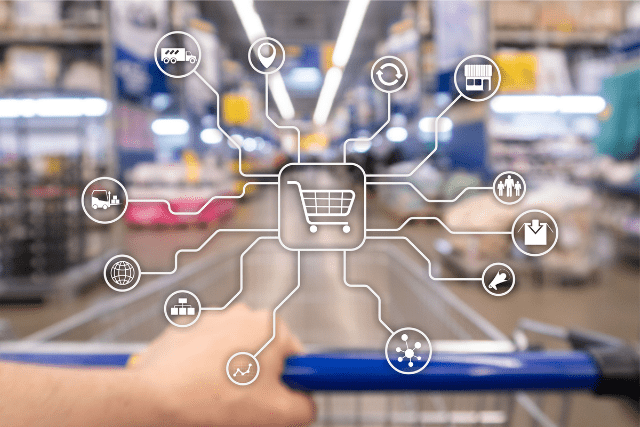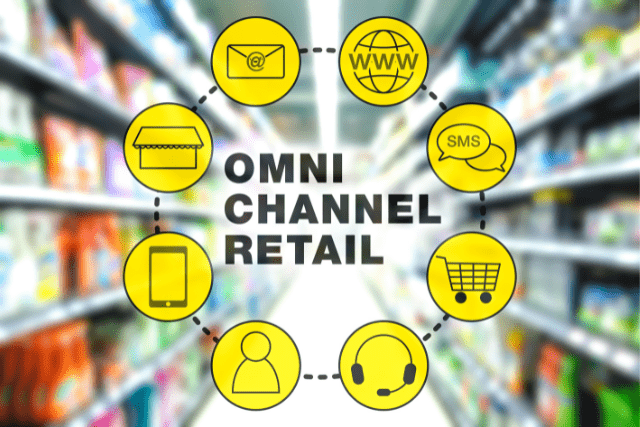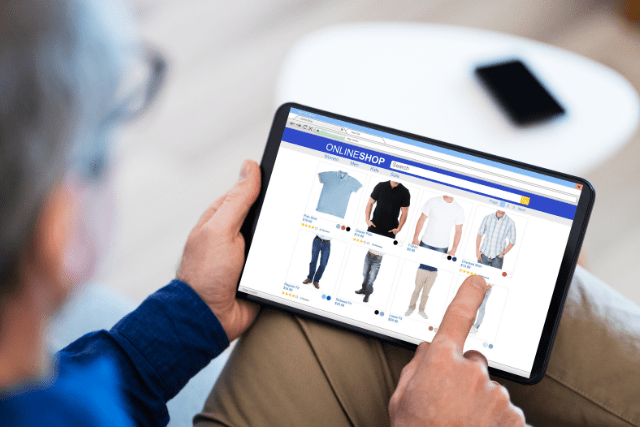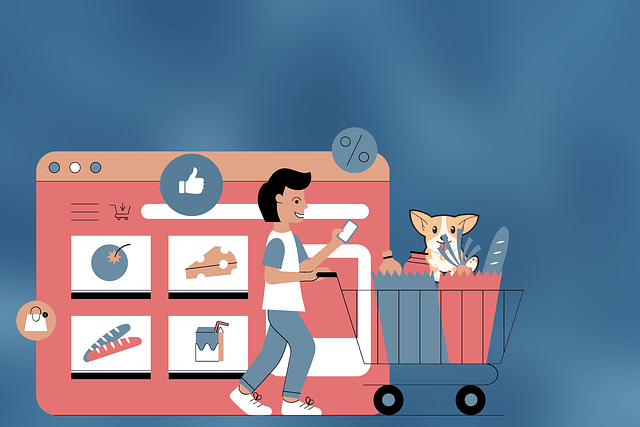In the fast-paced digital age, retailers face the challenge of meeting ever-changing consumer expectations. The traditional model of brick-and-mortar stores is no longer sufficient to satisfy the demands of today’s tech-savvy consumers. As technology reshapes the retail landscape, businesses must adapt and find innovative ways to bridge the gap between offline and online sales.
That’s where omnichannel commerce comes into the picture. It is a strategic approach integrating physical and digital channels to create a seamless customer experience. This article explores how omnichannel retailing has emerged as a powerful tool for retailers to survive and thrive in an increasingly competitive market.
Drawing on analytical insights and data-driven strategies, this article delves into the evolution of retail from brick-and-mortar establishments to e-commerce platforms. It examines how retailers have embraced omnichannel practices to harness technology, utilize customer data, and personalize experiences.
Furthermore, it addresses crucial elements such as building customer loyalty through omnichannel strategy, training staff for success, ensuring data security and privacy, and leveraging the power of omnichannel marketing.
This article aims to empower readers with valuable knowledge that can liberate them from outdated business models by adopting an objective and impersonal perspective while analysing these key aspects of omnichannel retailing.
Table of Contents
Key Takeaways
- Omnichannel retailing integrates physical and digital channels to provide a seamless customer experience.
- Personalization is crucial in omnichannel retailing to tailor the shopping experience to individual preferences.
- Leveraging technology and data-driven insights can enhance targeted marketing efforts and improve customer satisfaction.
- Offering convenient fulfilment options like click-and-collect and same-day delivery provides a better customer experience and drives revenue growth.
Understanding Consumer Expectations in the Digital Age
Consumer expectations in the digital age play a pivotal role in shaping the landscape of omnichannel retailing, as they demand seamless integration between offline and online sales channels. To understand these expectations, it is important to consider the evolving consumer behaviour and increasing reliance on technology for shopping.
Today’s consumers expect retailers to provide a consistent and personalized experience across all touchpoints. They want the convenience of browsing products online, comparing prices, reading reviews, and making purchases from the comfort of their own homes. At the same time, they also desire to visit physical stores to touch and feel products before making a final decision.
To meet these expectations, retailers must adopt an omnichannel retailing strategy that seamlessly integrates offline and online channels. By doing so, they can create a cohesive customer experience that transcends individual sales channels. This integration allows customers to start their journey on one channel (such as researching products online) and continue it on another (such as making a purchase in-store).
Integrating an omnichannel strategy enhances the customer experience and brings several benefits to retailers. It enables better inventory management by allowing real-time visibility across all sales channels, reduces costs associated with maintaining separate inventories for different channels, increases brand loyalty by providing consistent messaging across platforms, and ultimately drives higher sales conversion rates.
Understanding consumer expectations in the digital age is crucial for successful retail omnichannel implementation. Retailers must embrace an integrated approach that provides a seamless customer experience across all channels while reaping various operational benefits simultaneously.
The Evolution of Retail: From Brick-and-Mortar to E-commerce
The transformation of the retail industry from physical stores to online platforms has been a significant shift in recent years. This evolution can be attributed to the rise of e-commerce and technological advancements that have shaped consumer behaviour. In response to changing consumer expectations, retailers have adopted omnichannel retailing strategies to bridge the gap between offline and online sales.
- The first major change brought about by this evolution is the integration of offline and online retail strategies. Retailers now strive to create a seamless shopping experience for customers, allowing them to switch between channels effortlessly.
- Geographical boundaries no longer limit brick-and-mortar stores. With the advent of e-commerce, retailers can expand their customer base beyond their physical store locations.
- Innovations in retail technology have played a crucial role in this transformation. Technologies such as mobile apps, virtual reality, and augmented reality have enhanced customer engagement channels and provided unique shopping experiences.
- Lastly, data analytics has become an essential tool for retailers in understanding consumer behaviour and making strategic decisions. Retailers can personalise their marketing efforts by analyzing customer data across channels and improving overall customer satisfaction.
Retailers now employ omnichannel strategies that integrate offline and online sales, leverage new technologies, and utilize data-driven insights to enhance customer engagement and drive business growth.
The Rise of Omnichannel Retailing
One significant trend in the retail industry involves integrating various channels to provide a seamless shopping experience for customers. This is known as omnichannel retailing, which aims to bridge the gap between offline and online sales. The rise of omnichannel retailing can be attributed to the increasing popularity of online shopping and the changing preferences of consumers.
Omni-channel ecommerce combines multiple channels, such as physical stores, websites, mobile apps, and social media platforms, to create a unified customer experience. By offering different touchpoints for customers to interact with a brand, retailers can meet their needs at any stage of their buying journey.
Benefits of an Omnichannel Retailing
Implementing an omnichannel retail strategy has several benefits. Firstly, it allows retailers to reach a wider audience by expanding their presence across different channels. Secondly, it enables them to collect valuable data about customer behaviour and preferences, which can be used to personalize marketing efforts and improve customer satisfaction. Finally, seamless omnichannel retail experiences can increase customer loyalty and repeat purchases.
To illustrate the impact of omnichannel retailing on the industry, consider the following table:
| Retail Digital Transformation | Omnichannel Retail Benefits |
|---|---|
| Enhanced Customer Experience | Increased Sales |
| Personalized Marketing | Improved Customer Loyalty |
| Data-driven Decision Making | Wider Audience Reach |
As retailers adapt to changing consumer behaviours and preferences, embracing an omnichannel approach becomes crucial for staying competitive in today’s digital age.
Harnessing Technology for Seamless Customer Experiences
By harnessing the power of technology, retailers can create a seamless tapestry of customer experiences that transcends physical and virtual boundaries, transforming the shopping journey into a harmonious symphony of convenience and satisfaction. The impact of omnichannel retailing is undeniable.
It allows customers to engage with brands through various channels, such as websites, mobile apps, social media platforms, and physical stores. This integration ensures that customers have consistent interactions regardless of their chosen channel.
To achieve a seamless shopping experience, retailers must leverage retail technology and omnichannel solutions. Firstly, inventory management systems ensure product availability across all channels. Real-time updates on stock levels prevent overselling or disappointing customers with out-of-stock items. Secondly, personalized marketing strategies powered by data analytics enable targeted promotions and recommendations based on customer preferences and past purchases.

Thirdly, mobile devices are essential for bridging offline and online sales. Retailers can implement mobile payment options to streamline in-store and online checkout processes. Finally, augmented reality (AR) and virtual reality (VR) technologies provide immersive experiences for customers to visualize products before purchasing.
Harnessing technology for seamless customer experiences is vital in today’s omnichannel retail landscape. By adopting appropriate retail technologies and omnichannel solutions, retailers can enhance convenience for their customers while driving sales growth.
Useful Tools for Omnichannel Retailing
Numerous tools and platforms are available to help retailers implement an effective omnichannel strategy. These tools can assist with various aspects of omnichannel retailing, such as e-commerce, inventory management, customer relationship management, and marketing automation. Here are some popular tools to consider:
- E-commerce platforms enable you to create and manage your online store, integrate with various sales channels, and process transactions. Examples include:
- Shopify
- WooCommerce
- Magento
- BigCommerce
- Point-of-sale (POS) systems help manage in-store transactions, track inventory, and integrate with your e-commerce platform for a seamless omnichannel experience. Examples include:
- Square
- Shopify POS
- Lightspeed
- Vend
- Inventory management systems: These tools help you manage and track inventory across multiple channels, ensuring accurate stock levels and minimizing stockouts or overstocks. Examples include:
- Stitch Labs
- Zoho Inventory
- TradeGecko (QuickBooks Commerce)
- Cin7
- Customer relationship management (CRM) software: CRM systems help you manage customer data, track interactions, and personalize customer experiences across all channels. Examples include:
- Salesforce
- HubSpot CRM
- Microsoft Dynamics 365
- Zoho CRM
- Marketing automation platforms: These tools enable you to automate and personalize marketing campaigns across various channels, such as email, social media, and SMS. Examples include:
- Mailchimp
- Klaviyo
- ActiveCampaign
- Omnisend
- Social media management tools: These platforms help you manage your social media presence, schedule posts, and engage with customers across multiple social networks. Examples include:
- Hootsuite
- Buffer
- Sprout Social
- Agorapulse
- Customer support tools help you provide consistent and efficient customer support across various channels like email, live chat, and social media. Examples include:
- Zendesk
- Freshdesk
- Help Scout
- Intercom
- Analytics and reporting tools: These platforms help you track and analyze key performance indicators (KPIs) across all channels, providing insights to optimize your omnichannel strategy. Examples include:
- Google Analytics
- Adobe Analytics
- Mixpanel
- Looker
When selecting tools for your omnichannel retailing strategy, you must consider your business size, budget, and specific needs. Additionally, ensure that your chosen tools can integrate to provide a seamless and unified experience across all channels.
Utilizing Customer Data for Personalization
Utilizing customer data for personalization requires an in-depth analysis of consumer preferences and past purchases, enabling retailers to deliver tailored experiences that resonate with individual customers. This approach is crucial in the era of omnichannel retailing, where consumers expect a seamless and personalized shopping experience across multiple channels.
Retailers must adopt advanced data analysis techniques to utilize customer data for personalization effectively. Retailers gain insights into customers’ preferences and interests by analyzing large volumes of customer data, such as purchase history, browsing behaviour, and demographic information. These insights can create personalized recommendations, targeted marketing campaigns, and customized offers.
The table below illustrates the impact of utilizing customer data for personalization on key metrics:
| Metric | Without Personalization | With Personalization |
|---|---|---|
| Conversion Rate | 2% | 5% |
| Average Order Value | $50 | $75 |
| Customer Satisfaction | 3 out of 5 | 4.5 out of 5 |
| Repeat Purchase Rate | 20% | 35% |
As shown in the table above, personalization has a significant positive impact on various metrics. A higher conversion rate indicates more successful transactions, while an increase in average order value suggests that personalized recommendations lead to larger purchases. Moreover, improved customer satisfaction and repeat purchase rates demonstrate the effectiveness of personalized experiences in building long-term loyalty.
Incorporating customer data analysis into omnichannel retail strategies allows retailers to provide personalized shopping experiences that meet individual needs and preferences. By leveraging this valuable resource effectively, retailers can enhance engagement levels and drive business growth in today’s competitive market.
Integrating Online and Offline Inventory Management
Integrating inventory management across online and physical stores is crucial to optimizing retail operations. With the rise of omnichannel retail platforms, retailers face challenges in effectively managing their inventory to meet customer demands and improve overall efficiency. Implementing an efficient inventory management system that seamlessly integrates online and offline channels can provide numerous benefits for retailers.
To paint a picture for the audience, here are three key advantages of integrating online and offline inventory management:
- Real-time visibility: By integrating inventory data from both online and offline channels, retailers gain real-time visibility into their stock levels. This enables them to accurately track product availability across all channels, preventing overselling or stockouts. Retailers can also make informed decisions about replenishment strategies based on accurate demand forecasts.
- Improved order fulfilment: Integrating inventory management allows for more efficient order fulfilment processes. Retailers can fulfil orders from the most optimal location, whether from a nearby store or a centralized distribution centre. This reduces delivery time and cost while enhancing customer satisfaction.
- Enhanced customer experience: Integration of online and offline inventory ensures that customers can access accurate product information regardless of the channel they choose to shop from. Customers can quickly check product availability, reserve items for pickup, or return products through any preferred channel.
By optimizing retail with omnichannel strategies like integrating online and offline inventory management, retailers can strategically align their operations with customer expectations, increasing sales and improving customer loyalty.
Creating a Multi-channel and Unified Brand Experience
Creating a unified brand experience involves establishing a consistent and cohesive identity across all customer touchpoints, ensuring that every interaction reflects the brand’s values and messaging. This concept becomes crucial in bridging the gap between offline and online sales in omnichannel retailing. An effective omnichannel sales strategy necessitates an integrated approach encompassing physical and digital channels to provide customers with a seamless shopping experience.
To achieve a unified brand experience, retailers must first understand the differences between multichannel and omnichannel retail. While multichannel retail offers products through multiple channels, such as brick-and-mortar stores, websites, and mobile apps, omnichannel aims to create a holistic shopping experience by seamlessly integrating these channels. By doing so, customers can browse products online, make purchases in-store or vice versa, and access consistent information across all touchpoints.
Implementing retail omnichannel best practices is vital for creating a successful unified commerce strategy. This includes providing personalized recommendations based on customer behaviour data gathered from various channels, offering flexible fulfilment options like buy-online-pick-up-in-store (BOPIS) or ship-from-store services, and ensuring inventory accuracy across all locations.
By adopting an omnichannel approach and implementing these best practices, retailers can deliver an exceptional omnichannel shopping experience that meets the expectations of today’s liberated consumers who desire flexibility in their purchasing journey.
Offering Multiple Fulfillment Options
Offering customers a range of fulfilment options is crucial for providing a convenient and flexible shopping experience that meets their diverse needs. In the era of omnichannel marketing in retail, where consumers expect seamless integration between online and offline channels, retailers must adopt a cross-channel strategy that allows customers to switch between different platforms and fulfilment methods easily.
Retailers must first understand customer journey mapping to offer multiple fulfilment options effectively. By analyzing how customers move through different touchpoints, retailers can identify pain points and opportunities for improvement. This data-driven approach enables them to allocate resources and optimize their multiplatform retail operations strategically.
One popular fulfilment option is click-and-collect services, which allow customers to order products online and pick them up at a physical store. This not only provides convenience but also encourages foot traffic in brick-and-mortar stores. Retailers can leverage this opportunity by creating incentives or exclusive offers for customers who choose click-and-collect.
Moreover, offering additional fulfilment options such as same-day delivery or ship-to-store can enhance the customer experience. Retailers increase customer satisfaction and loyalty by giving shoppers the freedom to choose how they receive their purchases.
Incorporating multiple fulfilment options into an omnichannel retail strategy is essential for meeting customer expectations in today’s competitive market. Retailers should analyze customer journey data, implement click-and-collect services, and explore innovative ways to bridge the gap between offline and online sales while liberating customers through flexible shopping experiences.
Streamlining the Checkout Process
To optimize the customer experience and increase efficiency, it is crucial for retailers to streamline the checkout process to minimize wait times and reduce friction during the final stage of a purchase. This can be achieved through various strategies that leverage technology and data-driven insights.
Integrating ecommerce platforms with physical stores enables a seamless transition between online and offline transactions. By synchronizing inventory systems, retailers can offer customers the convenience of purchasing products online and picking them up in-store or vice versa. This enhances the overall customer experience and maximizes operational efficiency by reducing inventory carrying costs.
Embracing mobile commerce allows retailers to capitalize on the growing trend of consumers using their smartphones for shopping. By enabling mobile payments and providing personalized offers through mobile apps, retailers can create a frictionless checkout experience that caters to the preferences of digital-savvy customers.
Furthermore, physical store digitalization plays a vital role in streamlining the checkout process. Implementing self-checkout kiosks or mobile point-of-sale systems reduces reliance on traditional cash registers, minimizing waiting times and improving customer satisfaction.
Finally, deploying artificial intelligence (AI) technologies at retail touchpoints can further enhance checkout. AI-powered chatbots can assist customers with product recommendations or address any queries, reducing human intervention while maintaining personalized interactions.
By implementing strategies such as ecommerce integration, mobile commerce adoption, physical store digitalization, and AI utilization at retail touchpoints, retailers can streamline their checkout process to provide an efficient and convenient experience for customers while driving revenue growth.
Leveraging Mobile Technology for In-Store Engagement
In the previous subtopic, we discussed the importance of streamlining the checkout process to enhance the overall shopping experience for customers. Now, let us focus on leveraging mobile technology for in-store engagement.
Mobile technology has become an integral part of our lives, and retailers have recognized its potential as a tool for increasing customer engagement and loyalty. By incorporating in-store technology and virtual shopping experiences through mobile devices, retailers can provide seamless integration between their online and offline channels.
One effective way to leverage mobile technology is by implementing customer loyalty programs accessible through mobile apps. These programs incentivize customers to make repeat purchases and allow retailers to gather valuable consumer behaviour and preferences data. With this data, retail CRM software can personalize marketing strategies and create targeted promotions that resonate with individual customers.
Additionally, mobile technology enables retailers to offer a virtual shopping experience within physical stores. By utilizing augmented reality or virtual reality technologies, customers can virtually try on clothes or visualize how furniture would look in their homes before making a purchase decision.
Integrating mobile technology into the in-store environment allows retailers to enhance customer engagement, increase sales conversions, and foster lasting brand loyalty.
Implementing Click-and-Collect Services
Implementing click-and-collect services can give customers the convenience of ordering online and making purchases in-store, enhancing their shopping experience and saving them time. Click-and-collect is a key strategy in omnichannel retailing, as it helps bridge the gap between offline and online sales. This service allows retailers to leverage their physical stores as distribution centres, enabling customers to enjoy online and offline shopping benefits.
Click-and-collect services have gained popularity due to various reasons.
- It allows customers to shop whenever and wherever they want without waiting for delivery or paying additional shipping fees.
- It offers a seamless shopping experience by allowing customers to view product availability in real-time and reserve items for pickup at their preferred store location.
Furthermore, implementing click-and-collect services allows retailers to increase foot traffic in their brick-and-mortar stores. Studies have shown that customers who use click-and-collect often make additional purchases during their visit, increasing sales revenue. Additionally, this service enables retailers to strengthen customer loyalty by offering personalized experiences such as curbside pickup or expedited order processing.
Implementing click-and-collect services is a strategic approach for retailers aiming to enhance their omnichannel retailing capabilities. By providing convenience and saving time for customers while bridging the gap between offline and online sales channels, click-and-collect services contribute positively towards improving the overall shopping experience.
Enhancing Customer Service Across Channels
Enhancing customer service across multiple channels requires seamless integration of various touchpoints, ensuring customers receive consistent and personalized assistance throughout their shopping journey. In the era of omnichannel retailing, where businesses strive to bridge the gap between offline and online sales, customer-centric strategies have become imperative for success. Retailers must understand that providing exceptional customer service is not limited to just one channel; it should be extended across all platforms.
To achieve this, retailers must leverage technology and data-driven insights. Companies can tailor their offerings based on individual customer preferences by utilizing retail digital marketing techniques, such as targeted ads and personalized recommendations. This level of personalization enhances the overall shopping experience and fosters customer loyalty.
Furthermore, integrating offline and online channels through initiatives like buy online pick up in-store (BOPIS) allows customers to transition between different touchpoints seamlessly. Offering features like real-time inventory updates and easy returns across channels further enhances convenience for shoppers.

By enhancing customer service across channels, retailers can boost sales and build stronger customer relationships. As competition intensifies in the retail industry, providing exceptional customer service becomes a key differentiator for businesses seeking liberation from mediocrity.
Measuring Success in ecommerce: Key Metrics for Omnichannel Retailing
Measuring an integrated customer service strategy’s success requires identifying and tracking key metrics that reflect customer satisfaction and loyalty across various touchpoints. These metrics provide valuable insights into the effectiveness of an omnichannel retailing approach and help retailers optimize their strategies for future success.
Some key metrics for measuring the success of omnichannel retailing include:
- Customer Satisfaction: This metric measures how satisfied customers are with their overall shopping experience, including factors such as product availability, ease of navigation, and customer support. It can be measured through surveys, online reviews, or social media sentiment analysis.
- Customer Loyalty: This metric gauges customers’ loyalty to a particular brand or retailer across different channels. It can be measured by tracking repeat purchases, customer retention rates, and referrals.
- Conversion Rate: This metric tracks the percentage of website visitors who purchase or complete a desired action. It helps identify which channels or touchpoints drive the most conversions and where improvements can be made.
- Return on Investment (ROI): This metric assesses the financial impact of an omnichannel strategy by comparing the revenue generated against the costs incurred in implementing and maintaining it.
Successful examples from leading retailers demonstrate how effective measurement enables them to create seamless experiences across multiple channels while leveraging social media shopping trends.
Overcoming Challenges in Implementing Omnichannel Strategies
One of the challenges that retailers face when adopting a multi-channel approach is ensuring consistent brand messaging and customer experiences across different touchpoints. With the proliferation of online and offline channels, customers now have more options to engage with retailers. This presents a unique challenge for retailers who must ensure their brand message remains consistent across all channels.
To overcome this challenge, retailers must develop a clear and cohesive omnichannel strategy aligning with their business objectives. This involves integrating all online and offline channels to provide customers with a seamless shopping experience. By doing so, retailers can create a unified brand image that resonates with customers at every touchpoint.
Additionally, retailers should leverage data analytics to gain insights into customer behaviour and preferences. Retailers can identify patterns and trends that inform their omnichannel strategies by analysing customer data from various channels. For example, if a retailer notices that customers tend to browse products online but make purchases in-store, they can tailor their marketing efforts accordingly.
Furthermore, it is crucial for retailers to invest in technology infrastructure that supports omnichannel operations. This includes implementing robust inventory management systems and integrating backend processes across channels. Such investments enable efficient order fulfilment and inventory management while giving customers real-time visibility into product availability.
Overcoming the challenges associated with implementing omnichannel strategies requires careful planning and execution. Retailers must prioritize consistency in brand messaging and customer experiences while leveraging data analytics and technology infrastructure to drive strategic decision-making.
Case Study: Successful Examples of Omnichannel Retailing
Successful examples of implementing an integrated approach to customer engagement across various channels can be observed in the retail industry. These examples demonstrate the effectiveness of omnichannel strategies in bridging the gap between offline and online sales, ultimately enhancing customer experiences and driving sales growth.
- Starbucks: The coffee giant leverages its mobile app to allow customers to order ahead, earn rewards, and make payments seamlessly across multiple channels. This integration has resulted in increased customer loyalty and higher average spending.
- Nike: By integrating their online and offline channels, Nike provides customers a seamless experience. Customers can browse products online, customize them, and then try them on at physical stores before making a purchase decision.
- Best Buy: Its omnichannel approach enables customers to research products online, check availability at nearby stores, and even receive personalized recommendations based on browsing history. This integration has led to improved customer satisfaction and increased sales.
- Sephora: Sephora’s Beauty Insider program allows customers to earn online and offline rewards. Additionally, they provide virtual try-on tools on their website that enable customers to test makeup products virtually before purchasing them.
- Walmart offers buy-online-pickup-in-store (BOPIS) and free two-day shipping options for online purchases. These initiatives have improved convenience for customers and boosted sales for the company.
These successful examples highlight how retailers leverage omnichannel strategies to enhance customer engagement, increase brand loyalty, and drive revenue growth.
The Future of Omnichannel Retailing: Emerging Trends and Technologies
Building upon the successful examples of omnichannel retailing, it is crucial to explore the future of this approach and identify emerging trends and technologies that will shape the industry.
Retailers face challenges and opportunities in embracing new trends and technologies for their omnichannel strategies. One such trend is the increasing integration of artificial intelligence (AI) in retail operations.
AI-powered chatbots and virtual assistants have already gained prominence in providing personalized customer experiences across multiple channels. These intelligent systems can analyze vast amounts of data, enabling retailers to understand customer preferences better, anticipate needs, and deliver tailored recommendations.
Another emerging trend is using augmented reality (AR) to enhance the offline shopping experience. By overlaying virtual elements onto real-world environments, AR enables customers to try products virtually before purchasing. This not only bridges the gap between offline and online sales but also brings an element of fun and interactivity to the shopping process.
Furthermore, blockchain technology has immense potential for revolutionizing supply chain management in omnichannel retailing. With decentralized nature and transparent record-keeping capabilities, blockchain ensures greater accountability, traceability, and security throughout the supply chain network.
As omnichannel retailing continues to evolve, incorporating AI, AR, and blockchain technologies will be instrumental in delivering seamless customer experiences while bridging the gap between offline and online sales. Embracing these emerging trends will empower retailers to stay ahead of the competition while meeting ever-changing consumer demands.
Building Customer Loyalty through Omnichannel Experiences
Creating seamless and integrated experiences across various channels is essential to foster customer loyalty. Customers today expect a consistent and personalized experience, regardless of whether they are shopping online or in-store. By providing a cohesive omnichannel experience, retailers can build stronger customer relationships and increase their chances of repeat purchases.
One effective strategy for building customer loyalty through omnichannel experiences is personalized recommendations. Retailers can provide targeted product suggestions through multiple channels by analysing customer data and understanding their preferences. This enhances the shopping experience and increases the likelihood of customers finding products that meet their needs.
Another way to enhance customer loyalty is by offering convenient fulfilment options. For example, allowing customers to buy online and pick up in-store lets them choose the most convenient method while still receiving a seamless experience. Implementing these fulfilment options requires advanced inventory management systems that ensure accurate stock availability across all channels.
Furthermore, incorporating social media into the omnichannel strategy can significantly impact customer loyalty. Social media platforms allow retailers to engage with their audience more personally and build brand advocacy. By sharing user-generated content or responding promptly to customer inquiries, retailers can create a sense of community and strengthen customer relationships.
Building customer loyalty through omnichannel experiences requires retailers to focus on personalization, convenience, and engagement across various channels.

Training and Empowering Staff for Omnichannel Success
Staff training and empowerment are crucial for ensuring a cohesive and seamless customer experience across all channels. For example, a large department store could train its employees to have in-depth knowledge of online and offline products, allowing them to provide accurate information and assistance to customers regardless of their preferred shopping method.
By investing in comprehensive training programs, retailers can equip their staff with the necessary skills to navigate the complexities of omnichannel retailing. This includes educating employees on the various digital platforms and technologies used in online sales and familiarizing them with the store layout and inventory management systems.
Such knowledge enables staff members to assist customers efficiently, answer queries about product availability, and facilitate smooth transitions between online browsing and in-store purchasing.
Empowering staff is equally important to foster a customer-centric culture within the organization. Retailers can empower their employees by giving them decision-making authority when resolving customer issues or complaints. This improves customer satisfaction and boosts employee morale and job satisfaction. Moreover, ongoing training programs empower staff to adapt quickly to changing market dynamics and emerging technologies.
Adequate training coupled with empowerment of staff members plays a pivotal role in driving omnichannel success. Retailers can ensure consistent service delivery that meets customers’ expectations while fostering an environment conducive to innovation and growth by equipping employees with comprehensive knowledge about offline and online sales channels.
Ensuring Data Security and Privacy in Omnichannel Retailing
Data security and privacy are paramount in omnichannel operations, eliciting a sense of vulnerability and apprehension among consumers who entrust their personal information to retailers. As technology advances, the potential for data breaches and unauthorized access to customer data has become a significant issue that retailers must address. To ensure data security and privacy in omnichannel retailing, retailers should consider implementing the following measures:
- Encryption: Retailers should encrypt sensitive customer information to protect it from unauthorized access.
- Secure payment gateways: Retailers should use secure payment gateways that comply with industry standards to safeguard customer financial data.
- Regular audits: Conduct audits of systems and processes to identify any vulnerabilities or weaknesses that cybercriminals could exploit.
- Employee training: Train employees on best practices for handling customer data securely and educate them about potential threats such as phishing attacks.
- Privacy policies: Communicate privacy policies to customers, outlining how their personal information will be collected, stored, and used.
By adopting these strategies, retailers can instil consumer confidence regarding protecting their data. This not only ensures compliance with regulations but also strengthens brand reputation. Ultimately, prioritizing data security and privacy liberates customers from concerns about identity theft or misuse of their personal information when engaging in omnichannel transactions.
Embracing the Power of Omnichannel Marketing
As consumers increasingly navigate seamlessly between different channels, retailers can harness the immense power of integrating their marketing efforts across multiple platforms and touchpoints, creating a cohesive and immersive brand experience. Embracing the power of omnichannel marketing allows retailers to reach customers at various stages of their purchasing journey, capturing their attention and driving conversions.
One key advantage of omnichannel marketing is its ability to provide a consistent message across different channels. By aligning messaging and creative assets, retailers can ensure that customers receive a unified brand experience regardless of where they interact with the brand. This consistency builds customer trust and loyalty, enhancing their overall brand perception.
Moreover, leveraging data from various channels enables retailers to gain valuable insights into customer behaviour and preferences. Analyzing this data allows them to personalize marketing messages and offers, delivering relevant content to individual customers based on their past interactions. This level of personalization enhances customer engagement and increases the likelihood of conversion.
Additionally, omnichannel marketing empowers retailers to optimize their advertising spend by targeting specific audiences more effectively. By understanding which channels drive higher engagement or conversions for different segments, retailers can allocate resources strategically to maximize ROI.
Embracing the power of omnichannel marketing creates a cohesive brand experience and provides opportunities for data-driven strategies that enhance customer engagement and optimize advertising effectiveness. Retailers who successfully implement these tactics are well-positioned to thrive in today’s competitive landscape.
Frequently Asked Questions
How can retailers effectively measure the success of their omnichannel strategies?
Retailers can effectively measure the success of their omnichannel strategies by employing a data-driven approach. They must track key performance indicators such as conversion rates, customer acquisition costs, and average order value across different channels.
Additionally, retailers should leverage analytics tools to gain insights into customer behaviour and preferences, enabling them to optimize their omnichannel offerings.
By analyzing these metrics and continuously refining their strategies, retailers can assess the effectiveness of their omnichannel initiatives and make data-informed decisions for future improvements.
What are the key benefits of omnichannel retailing?
An omnichannel retailing strategy offers numerous benefits, including enhanced customer experience, increased sales, improved customer insights, inventory optimization, competitive advantage, brand consistency, greater customer retention, and increased efficiency. By adopting this approach, retailers can better meet their customer’s evolving needs and preferences, ultimately driving growth and success in today’s competitive retail landscape.
What are some common challenges faced by retailers when implementing omnichannel strategies?
What are the common challenges faced by retailers when implementing omnichannel strategies? The implementation of omnichannel strategies poses several challenges for retailers.
One of the key challenges is managing customer expectations across multiple channels. Retailers need to ensure a seamless and consistent buying experience for customers, regardless of the channel they choose to engage with.
Another challenge is integrating various systems and technologies to enable real-time inventory visibility and order management. This requires significant investment in infrastructure and data integration capabilities.
Additionally, retailers must address privacy concerns in sales and marketing associated with collecting and analyzing customer data across different channels while complying with regulations.
Can you provide some successful examples of companies implementing omnichannel retailing successfully?
Successful examples of companies implementing omnichannel retailing include Walmart, Nike, and Starbucks. Walmart has embraced omnichannel strategies by integrating its online and offline platforms, offering features like in-store pick-up for online purchases.
Nike has leveraged technology to improve the customer experience through personalized recommendations and easy access to product information across channels. Starbucks has successfully implemented mobile ordering and payment options, allowing customers to seamlessly transition between their app, website, and physical stores.
These companies success can be attributed to their strategic use of data-driven insights and customer-centric approaches.
What emerging trends and technologies are shaping the future of omnichannel retailing?
Emerging trends and technologies are revolutionizing the future of retailing, notably omnichannel strategies. The euphemistic term “retail liberation” encapsulates the transformative shift towards a seamless customer experience across offline and online channels.
Data-driven analytics play a pivotal role in this paradigm, enabling retailers to identify consumer preferences and tailor offerings accordingly. Strategic implementation of artificial intelligence, augmented reality, and virtual reality enhance customer engagement by providing immersive shopping experiences.
Omnichannel retail is a strategy that empowers retailers to bridge the gap between physical stores and digital platforms, driving growth and loyalty in an increasingly competitive market.
How can retailers ensure data security and privacy in their omnichannel operations?
Retailers must implement robust measures to ensure data security and privacy in omnichannel operations. This includes utilizing encryption techniques to protect customer information during transmission and storage. Regular systems audits should be conducted to identify vulnerabilities and address them promptly.
Retailers should also adhere to regulations such as the General Data Protection Regulation (GDPR) and Payment Card Industry Data Security Standard (PCI DSS). By prioritizing data security, retailers can build customer trust and safeguard sensitive information throughout their omnichannel operations.
Conclusion
Omnichannel retailing has become a strategic imperative for businesses looking to bridge the gap between offline and online sales. Retailers can create personalised journeys that enhance customer loyalty by understanding consumer expectations in the digital age and harnessing technology for seamless customer experiences.
Also, businesses can ensure a consistent and cohesive brand experience across all touchpoints by training and empowering staff to deliver omnichannel success. With data security and privacy measures in place, retailers can confidently embrace the power of omnichannel marketing to drive growth and stay ahead of the competition.







